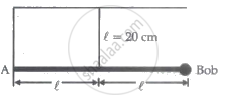Advertisements
Advertisements
Question
A simple pendulum is constructed by hanging a heavy ball by a 5.0 m long string. It undergoes small oscillations. (a) How many oscillations does it make per second? (b) What will be the frequency if the system is taken on the moon where acceleration due to gravitation of the moon is 1.67 m/s2?
Solution
It is given that:
Length of the pendulum, l = 5 m
Acceleration due to gravity, g = 9.8 ms-2
Acceleration due to gravity at the moon, g' = 1.67 ms-2
(a) Time period \[\left( T \right)\] is given by,
\[T = 2\pi\sqrt{\frac{l}{g}}\]
\[= 2\pi\sqrt{\frac{5}{9 . 8}}\]
\[ = 2\pi\sqrt{0 . 510} = 2\pi \left( 0 . 71 \right) s\]
i.e. the body will take 2 \[\pi\](0.7) seconds to complete an oscillation.
Now, frequency \[\left( f \right)\]is given by,
\[f = \frac{1}{T}\]
\[\therefore f = \frac{1}{2\pi\left( 0 . 71 \right)} \]
\[ = \frac{0 . 70}{\pi} Hz\]
(b) Let
\[g'\] be the value of acceleration due to gravity at moon. Time period of simple pendulum at moon \[\left( T' \right)\],is given as:
\[T' = 2\pi\sqrt{\left( \frac{l}{g'} \right)}\]
On substituting the respective values in the above formula, we get:
\[ = \frac{1}{2\pi}\sqrt{\frac{1 . 67}{5}} = \frac{1}{2\pi}\left( 0 . 577 \right)\]
\[ = \frac{1}{2\pi\sqrt{3}} Hz\]
APPEARS IN
RELATED QUESTIONS
The average displacement over a period of S.H.M. is ______.
(A = amplitude of S.H.M.)
Which of the following relationships between the acceleration a and the displacement x of a particle involve simple harmonic motion?
(a) a = 0.7x
(b) a = –200x2
(c) a = –10x
(d) a = 100x3
A body of mass 1 kg is made to oscillate on a spring of force constant 16 N/m. Calculate:
a) Angular frequency
b) frequency of vibration.
A small creature moves with constant speed in a vertical circle on a bright day. Does its shadow formed by the sun on a horizontal plane move in a sample harmonic motion?
Can the potential energy in a simple harmonic motion be negative? Will it be so if we choose zero potential energy at some point other than the mean position?
A pendulum clock gives correct time at the equator. Will it gain time or loose time as it is taken to the poles?
A student says that he had applied a force \[F = - k\sqrt{x}\] on a particle and the particle moved in simple harmonic motion. He refuses to tell whether k is a constant or not. Assume that he was worked only with positive x and no other force acted on the particle.
Figure represents two simple harmonic motions.
The parameter which has different values in the two motions is

A particle moves on the X-axis according to the equation x = x0 sin2 ωt. The motion is simple harmonic
In a simple harmonic motion
(a) the maximum potential energy equals the maximum kinetic energy
(b) the minimum potential energy equals the minimum kinetic energy
(c) the minimum potential energy equals the maximum kinetic energy
(d) the maximum potential energy equals the minimum kinetic energy
The pendulum of a certain clock has time period 2.04 s. How fast or slow does the clock run during 24 hours?
Assume that a tunnel is dug across the earth (radius = R) passing through its centre. Find the time a particle takes to cover the length of the tunnel if (a) it is projected into the tunnel with a speed of \[\sqrt{gR}\] (b) it is released from a height R above the tunnel (c) it is thrown vertically upward along the length of tunnel with a speed of \[\sqrt{gR}\]
A uniform disc of mass m and radius r is suspended through a wire attached to its centre. If the time period of the torsional oscillations be T, what is the torsional constant of the wire?
A particle is subjected to two simple harmonic motions given by x1 = 2.0 sin (100π t) and x2 = 2.0 sin (120 π t + π/3), where x is in centimeter and t in second. Find the displacement of the particle at (a) t = 0.0125, (b) t = 0.025.
A particle is subjected to two simple harmonic motions, one along the X-axis and the other on a line making an angle of 45° with the X-axis. The two motions are given by x = x0 sin ωt and s = s0 sin ωt. Find the amplitude of the resultant motion.
The length of a second’s pendulum on the surface of the Earth is 0.9 m. The length of the same pendulum on the surface of planet X such that the acceleration of the planet X is n times greater than the Earth is
Define the frequency of simple harmonic motion.
What is an epoch?
A body having specific charge 8 µC/g is resting on a frictionless plane at a distance 10 cm from the wall (as shown in the figure). It starts moving towards the wall when a uniform electric field of 100 V/m is applied horizontally toward the wall. If the collision of the body with the wall is perfectly elastic, then the time period of the motion will be ______ s.

A weightless rigid rod with a small iron bob at the end is hinged at point A to the wall so that it can rotate in all directions. The rod is kept in the horizontal position by a vertical inextensible string of length 20 cm, fixed at its midpoint. The bob is displaced slightly, perpendicular to the plane of the rod and string. The period of small oscillations of the system in the form `(pix)/10` is ______ sec. and the value of x is ______.
(g = 10 m/s2)

